During the ripening of the harvest, raspberry bushes often bend from the load of fruits or strong wind, which complicates the collection of berries. For the convenience of work when harvesting, one particular agro-reception is used - fixing plants on supports, made in the form of a horizontal or vertical plane. For this purpose, it is best to use a special trellis, although some gardeners tie bushes to separate stakes. How to make a bed for raspberries and a trellis with your own hands, you can find below.
Table of contents
Purpose and advantages of the trellis for raspberry growing
To get started, let's look at the destination of the trellis. The fact is that the majority of modern, high-yielding varieties of the described berries have a significant height, about 1.6-1.8 meters, so some plants do not withstand the load of the crop. All of them have sufficiently developed lateral fruit branches, which, when ripe, tilt down. Without the garter of the bushes planted in rows can not do, a trellis is used for this purpose. When growing new varieties that are planted in small quantities in different parts of the garden, separate props and supports are used.
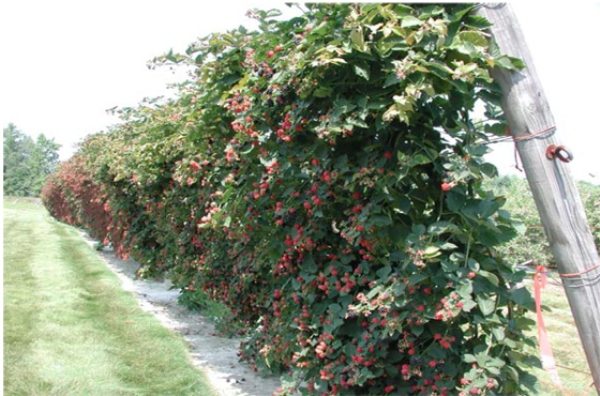
The advantages of using a trellis in raspberries are obvious:
- if you tie up the bushes, the lower branches will not touch the groundtherefore the surface of the berries and leaves will not be contaminated by the soil;
- there are no traces of dirt on the fruits after heavy rain;
- raspberry rows blown well by the windthat prevents the development of various diseases;
- raspberry bushes get enough sunlightthat will promote more uniform ripening of the crop.
The use of a trellis in the garden also simplifies the maintenance of the raspberries and serves as a fence. After the garter of the bushes, it is much more convenient to carry out such agrotechnical measures as pruning of crops, removal of damaged and fruit bearing shoots. It is easier to water and mulch the plants, clean ripe berries, prepare the bushes for the winter.
Variants of design trellis
Tapestry for raspberry - this is a special design, which is a series of pillars. Between them, at a certain height, several rows of metal wire or a reinforced rope are stretched, and fittings can also be used. In practice, two basic types of trellis are used: single-sided or double-sided. According to experienced gardeners, the first type of trellis is better to use on small-sized areas.
Single strip trellis, ways of garter berries
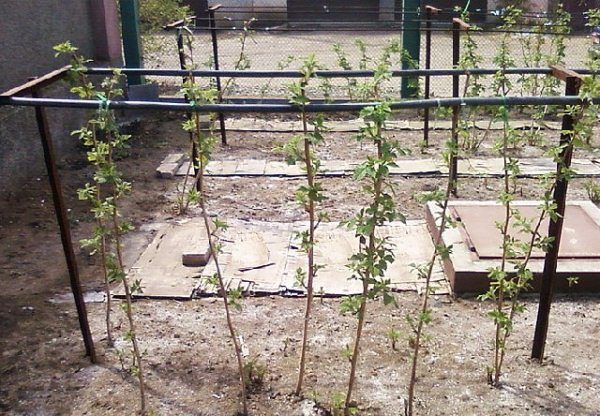
The main purpose of the described support structure is to keep the shootsraspberries over stretched wire or twine. In this case the berry is done in the following ways.:
- in the vertical direction;
- under a certain bias;
- fan;
- free placement of fruit branches.
All the described methods of garter are possible on one type of trellis, when the branches of the plant are fixed in a certain order between the rows of the wire.
In this case, during the installation of a trellis in early spring, branches from the previous year are bent to the ground and fixed horizontally. During the growing season, the fruit branches will start to grow upwards, but dormant buds will remain on the main shoot near the base. This method of forming a bush simplifies the work of sheltering a raspberry plantation for the winter.. The disadvantage of the described method is the need for fastening and garter every bush. On a small raspberry field, such works will not cause much trouble to the gardener, but if there is a large plantation, the need to garter each plant is considered a disadvantage.
Double lanes
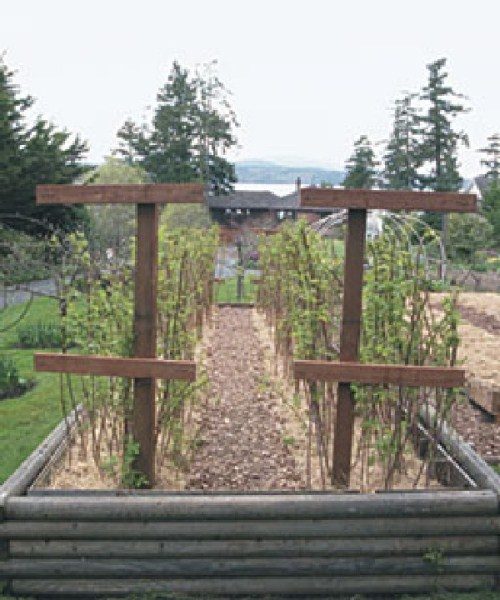
With significant plantings, it is recommended to use two-way supports. Such designs can be divided into several varieties:
- in the shape of the letter T;
- horizontal tent;
- as symbol V;
- in the form of the letter Y.
The considered supports are made in the form of two rows of wire parallel to each other. The height of the placement of the rails may be different. The bottom row is located at a distance of 50 centimeters from the surface of the earth. The upper tier of the wire can be installed at 3 meters, it depends on the height of the bushes. This design prevents thickening of plantations., makes it possible to orient the fruiting shoots in different directions, which speeds up the ripening of the crop.
T-shaped tapestry
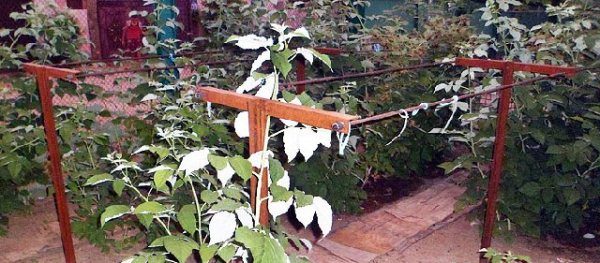
As can be understood from the name of the described design is made in the form of supports T-shaped. The main material for the device racks such a trellis are wooden bars, metal pipes, as well as trimming fittings.Usually such elements in the upper part are fixed perpendicular to each other. The rows of wire need to be fixed on the protruding edges of the strap. During the formation of the bush shoots are laid on different sleeves of the trellis. In this case, in the center of the plant, young growth begins to form, which is almost not obscured by the main fruiting plants.
V shaped support
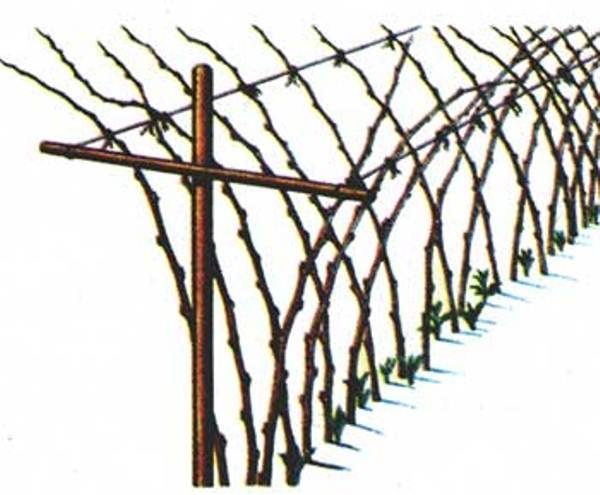
In the construction under consideration, two working planes lean from the middle of the bushes to the sides. In this regard, such the trellis is often called a two-lane sloping. The formation of plants occurs according to the previous scheme, but the distance between the edges of the working planes should not be larger than 2 meters.
Y shaped trellis
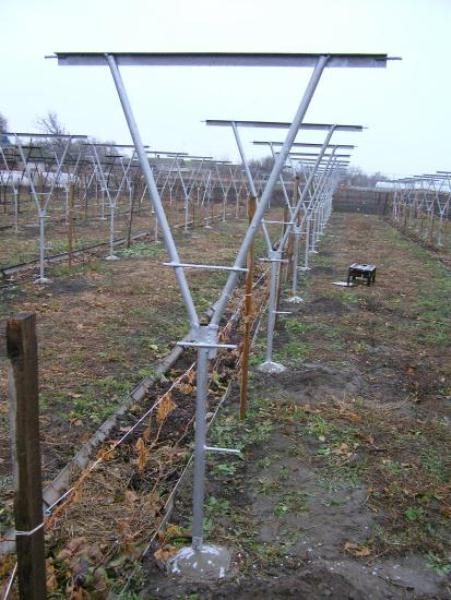
This is the latest version of the trellis for tying and care of raspberry bushes. A feature of this design is the use of hinges and blades., which helps to orient the working plane of the tapestry in a convenient direction at a certain angle. In summer, the blades are lifted, lowered for winter or spring, which makes it possible to build a shelter to protect plants from the cold.
How to make a trellis with your own hands, the size of the supports
As we described above, all types of trellis are made of wooden or metal supports of various shapes between which wire is stretched at a certain height. And wire tiers can be single or pairedIt depends on the type of trellis.
For the manufacture of a trellis in the form of a vertical plane on the site in a certain direction, drive in wooden pegs and pull the cord. After that, digging holes every two or three meters with a shovel or a special garden drill. In the pits to a depth of 0.7 meters set wooden posts, and then stretch and fix on the supports a few rows of wire (usually three). The first row of guides is fixed at a distance of 40-50 centimeters from the surface of the earth, the second in the central part of the shoots of the bush, the last row of wire should be located 20 centimeters below the tops of the raspberry.
When the device is a T-shaped tapestry, separate tapestries are in the form of a letter T.In this case, the main stand of wooden bars or metal should have a height of about 1.2-1.3 meters. The cross-bar is attached to the base with nails (for wooden products) or by welding (for metal pipes). On the main trellis column install two rows of wire and two more sides of the top. In this way during ripening berries fruit branches will lay on the wire, but the middle part of the bushes will not sag from gravity, because the stalks of the plants will be fixed on the lower rows of the wire.
The scheme of planting raspberries on the trellis, preparing the beds
To obtain good yields of raspberries on the trellis it is necessary to prepare the land in time for planting crops. In this case raspberries are planted in one rowthat will simplify the care of the culture. First, a shallow trench is pulled out, approximately on a spade bayonet up to 50 centimeters wide.At the site of planting, the soil is loosened with garden forks. At this point, water is poured at the rate of 10 liters of fluid per meter of row, the ground thrown out of the groove is thoroughly mixed with complex mineral fertilizers and wood ash (for every meter of row you need to take a liter jar of ash and 200 grams of nitroammofoski).
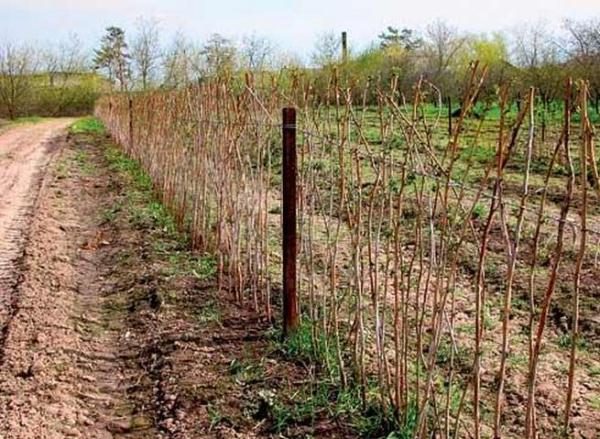
The prepared raspberry seedlings are laid out at a distance of 25 centimeters from each other, after which they straighten the root system of the plants and sprinkle them with nutritious soil. To improve the contact of the roots with the ground, the soil is compacted and then irrigated.. When plants are planted in early spring, the bushes are cut so that the upper part of the shoot protrudes about 20-30 centimeters above the ground level, followed by mulching of the soil using sawdust or broken straw.
During the growing season as the growth of raspberries tied to the rows of wire trellis. As we have said, the individual columns of the trellis are installed at a distance of 2-3 meters from each other (using powerful supports, the distance can be increased to 4-5 meters). To increase the service life of wooden poles, their base, which will be located in the ground, is coated with hot resin or calcined. Note that the diameter of the pillars should be no less than 15 centimeters, a height of about 2 meters. To install the columns usually use a shovel, less often a special auger. Rows of wire or reinforcement are installed between the columns every 50 centimeters.
Raspberry Care: Feeding, Watering and Pest Control
The main care for raspberries begins during the first fruits. In this period it is necessary to carry out periodic watering of the soil, to loosen the aisles, to destroy weeds. A layer of mulch will help keep moisture in the ground during the growing season.
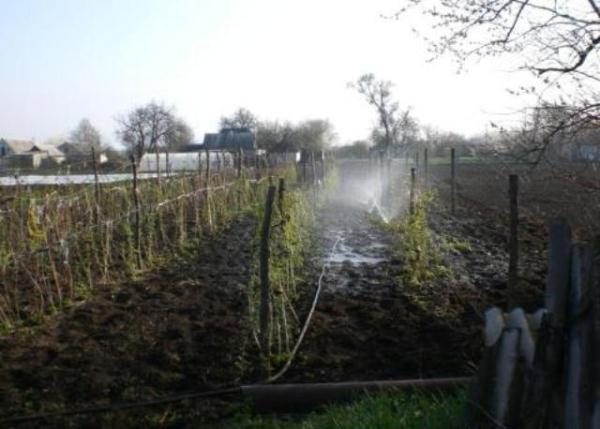
The first feeding raspberries carried out with the use of complex mineral fertilizers in early spring. In this situation, the water that is released after the snow melts will dissolve the granules of nutrients and will contribute to their penetration into the soil before the root system of the plants.
The second feeding of berries held during the formation and ripening of the crop. The third soil enrichment with useful substances is carried out in the autumn period. When preparing raspberries for winter, it is important not to fertilize it with nitrogen, because this element stimulates the development of plants. Concerning for the winter raspberries are fed with a mixture of potassium and phosphorus. Increase the amount of fertilizer during the growing season is not necessary. A greater amount of nutrients in the soil will contribute to the development of green mass, but will not increase the yield.
With pests and diseases begin to fight in the spring. To begin with, cultures are examined for damage. The leaves damaged by the chapel are cut and burned. The remaining stands are treated with a Bordeaux mixture of 4% concentration. This drug is used to prevent fungal diseases. For the destruction of insecticides on planting raspberries are used insecticides.
Another measure of care for the considered berries is timely pruning. During these operations, the most developed stems are left at the site, the rest are cut out. Proper care of the described culture, timely watering, feeding and pruning,tying shoots to the wire will allow you to harvest a rich harvest. In our article, we learned how to make a raspberry trellis and care for this culture. I hope that the information provided will be useful, good luck and good harvests to you.
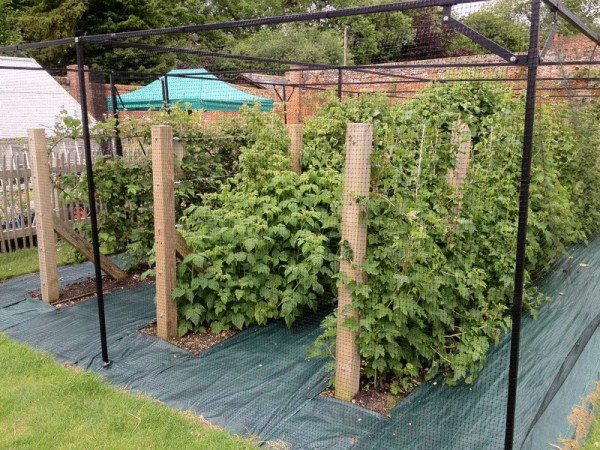
Very accessible and understandable advice! Thank!